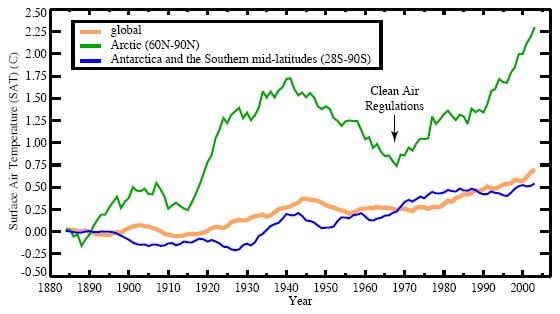Original URL: https://www.theregister.com/2009/04/09/arctic_aerosols_goddard_institute/
NASA: Clean-air regs, not CO2, are melting the ice cap
Acid-rain countermeasures could drown London
Posted in Science, 9th April 2009 12:10 GMT
Opinion New research from NASA suggests that the Arctic warming trend seen in recent decades has indeed resulted from human activities: but not, as is widely assumed at present, those leading to carbon dioxide emissions. Rather, Arctic warming has been caused in large part by laws introduced to improve air quality and fight acid rain.
Dr Drew Shindell of NASA's Goddard Institute of Space Studies has led a new study which indicates that much of the general upward trend in temperatures since the 1970s - particularly in the Arctic - may have resulted from changes in levels of solid "aerosol" particles in the atmosphere, rather than elevated CO2. Arctic temperatures are of particular concern to those worried about the effects of global warming, as a melting of the ice cap could lead to disastrous rises in sea level - of a sort which might burst the Thames Barrier and flood London, for instance.

Acid rain fixed, woo! Hey, what's that gurgling sound?
Shindell's research indicates that, ironically, much of the rise in polar temperature seen over the last few decades may have resulted from US and European restrictions on sulphur emissions. According to NASA:
Sulfates, which come primarily from the burning of coal and oil, scatter incoming solar radiation and have a net cooling effect on climate. Over the past three decades, the United States and European countries have passed a series of laws that have reduced sulfate emissions by 50 percent. While improving air quality and aiding public health, the result has been less atmospheric cooling from sulfates.
Meanwhile, levels of black-carbon aerosols (soot, in other words) have been rising, largely driven by greater industrialisation in Asia. Soot, rather than reflecting heat as sulphates do, traps solar energy in the atmosphere and warms things up.
The Arctic is especially subject to aerosol effects, says Shindell, because the planet's main industrialised areas are all in the northern hemisphere and because there's not much precipitation to wash the air clean.
"Right now, in the mid-latitudes of the Northern Hemisphere and in the Arctic, the impact of aerosols is just as strong as that of the greenhouse gases," says Shindell.
Dirty Chinese coal to save us all?
Other scientists have recently suggested that it's not just the Arctic which is subject to aerosol effects. Boffins from the US National Oceanic and Atmospheric Administration have said that aerosol levels from dust storms and volcanoes alone would account for as much as 70 per cent of the temperature rise seen in the Atlantic ocean during the past 26 years, leaving carbon simply nowhere.
Shindell's new NASA study is particularly topical, as President Obama's new science advisor has just suggested that the subject of "geoengineering" - artificially modifying the climate - must be considered as a countermeasure to global warming. One measure put forward by geoengineering advocates is the deliberate injection of sulphur particulates into the atmosphere.
There might not even be any need for action on the part of the West, with China building sulphur-belching coal power stations and diesel vehicles at a furious rate in recent times. Dr Shindell doesn't say so, but it's at least possible that this has something to do with the fact that global temperatures have actually dipped slightly over the last couple of years.
Meanwhile Dr Shindell's position at NASA's Goddard Institute in New York must now be a potentially stressful one. His boss, Dr James Hansen, is more or less the father of the carbon-driven global warming menace. He won't be pleased at the suggestion that carbon emissions may not be such an overriding concern after all. Dr Hansen has even gone so far as to travel to the UK, to add his weight to protests against the Kingsnorth coal plant.
There are of course many arguments against a deliberate policy of sulphate emissions. They cause acid rain, for one thing: the original anti-sulphur regs weren't introduced just for fun. But the appearance of aerosols at the front of the climate-science stage does indicate that the issue isn't simple, and that environmental policies can have unforeseen and unexpected effects.
The goal of simply cutting CO2 emissions by any means possible might have to be reconsidered somewhat: Shindell's research, backed by other recent studies, suggests that it might be a lot more cost-effective to tackle emissions of black-carbon aerosols. Filtering soot from exhausts would be hugely easier than capturing and sequestering CO2, building a fully wind/electric Blighty or other ambitious eco-schemes.
"There's still a lot more that we need to sort out," says Shindell, in understated style.
There's more for laymen from NASA here, or subscribers to Nature Geoscience can read the relevant journal article here, and expert commentary here. ®